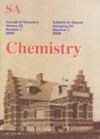用概念DFT了解两种槲皮素-锑配合物的检出限与能量稳定性的关系
IF 1
4区 化学
Q4 CHEMISTRY, MULTIDISCIPLINARY
South African Journal of Chemistry-Suid-Afrikaanse Tydskrif Vir Chemie
Pub Date : 2020-01-01
DOI:10.17159/0379-4350/2020/V73A17
引用次数: 3
摘要
鉴于槲皮素及其衍生物在痕量金属分析中的重要性,通过密度泛函理论(DFT)计算,对槲皮素(Q)和槲皮素-5-磺酸(QSA)与金属锑形成的两种有机金属配合物进行了理论研究。本研究以Q和QSA为配体,将电分析中检出限的概念与水溶液中痕量锑分析的量子化学计算联系起来。基于之前的两份报告,本研究采用极谱法进行实验,其中工作电极为滴汞电极。DFT计算采用高斯09程序实现的B3LYP和LSDA泛函,分别采用6-31G(d)和3-21G(d)基集。结果表明,锑配合物的总能量与检出限之间有很强的关系;因此,越稳定的配合物检测极限值越好。基于Fukui函数,计算得到的配体的局部亲核指数和HOMO-1电子密度等参数表明,锑离子(III)与槲皮素-5-磺酸的相互作用比与槲皮素的相互作用高。这一发现与实验结果吻合较好。本文章由计算机程序翻译,如有差异,请以英文原文为准。
Understanding the Link Between the Detection Limit and the Energy Stability of Two Quercetin-Antimony Complexes by Means of Conceptual DFT
In view of the importance of quercetin and its derivatives in trace metal analyses, two organometallic complexes formed between quercetin (Q) and quercetin-5-sulfonic acid (QSA) with antimony metal, were theoretically studied via density functional theory (DFT) calculations. In this study, the concept of detection limit in electroanalysis was correlated to quantum chemical calculations for antimony trace analysis in aqueous solution by using Q and QSA as ligands. Based on two previous reports, the study was carried out experimentally using polarography where the working electrode was a dropping mercury electrode. The DFT calculations were performed with B3LYP and LSDA functionals as implemented in Gaussian 09 program and by employing the 6-31G(d) and 3-21G(d) basis sets, respectively. The results show a very strong relationship between the total energy of antimony complexes and the detection limit; thus, the more stable complex has a better detection limit value. Based on the Fukui functions, the calculated parameters such as local nucleophilicity indices and HOMO-1 electronic density of the ligands show a high interaction of antimony ion (III) with quercetin-5-sulfonic acid than that with quercetin. This finding was in good accord with the experimental results.
求助全文
通过发布文献求助,成功后即可免费获取论文全文。
去求助
来源期刊
CiteScore
3.10
自引率
0.00%
发文量
6
审稿时长
>12 weeks
期刊介绍:
Original work in all branches of chemistry is published in the South African Journal of Chemistry. Contributions in English may take the form of papers, short communications, or critical reviews.

 求助内容:
求助内容: 应助结果提醒方式:
应助结果提醒方式:


